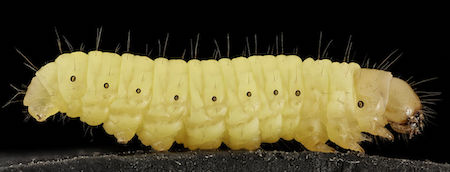Pollution became a serious issue in our modern world. Since it takes approximately 400-500 years for plastic to degrade, the pollutant became an epidemic and it was thought to be indestructible, let alone edible, but researchers from Stanford may offer a solution: plastic-eating worms.
A common type of larvae known as mealworms might hold the key to global waste pollution. A study by researchers from China and Stanford proves that the mealworms are able to digest and biodegrade polyethylene, a common form of plastic. These worms, the larvae form of a darkling beetle, can subsist on a diet based solely on polystyrene because of the microorganisms in the worm’s guts, as stated by studies co-authored by Wei-Min Wu, a senior research engineer in the Department of Civil and Environmental Engineering at Stanford.

The worms are able to turn half of the Styrofoam they ingest into carbon dioxide (as they would do with any ingested food), worm biomass and biodegradable waste, which seems safe to use in the soil for plants. In the lab, 100 mealworms ate between 34 and 39 milligrams of Styrofoam per day, which is the weight of a small pill, without suffering any ill effects.
“The findings are revolutionary. This is one of the biggest breakthroughs in environmental science in the past 10 years,” Wei-Min Wu said in an interview with CNN.
The secret is an efficient gut rich in bacteria. In order to prove that, the scientists fed mealworms antibiotics, then plastic, and as a result, the plastic was not degraded. The researchers’ goal is to understand the mechanism of a worm’s gut, so the scientists and engineers will be able to create either new ways of degrading plastic waste or to create biodegradable plastic that will replace the one we are currently using, which takes hundreds of years to degrade.
Scientist plan to study if the microorganism inside a worm’s guts can degrade polypropylene, another form of plastic used to make things such as certain car parts and packaging for consumer products, textiles and microbeads( a microbead is any plastic that is smaller than 1 mm; many companies have added microbeads to body scrubs and cosmetics to create an exfoliating sensation for users)
Moreover, mealworms are not the only insects with the capability to degrade ingested plastic. Waxworms or the Indian-meal moths (the larvae of Plodia interpunctella) were found to be capable of chewing and eating plastic films. According to NCBI, The National Center for Biotechnology Information, over a 28-day incubation period of the two bacterial strains capable of degrading plastic, isolated from this worm’s gut on PE films, obvious damage, including pits and cavities were observed using scanning electron microscopy and the results provided promising evidence for the biodegradation of PE in the environment.
Pollution is an increasing problem, with garbage waste islands twice as big as the size of Texas, where 1 million seabirds and 100,000 sea mammals are killed every year by it. Pollution greatly affects mankind, where people living in places with high levels of air pollutants present 20% higher risk of death from lung cancer than people who live in less-polluted areas. Solutions and awareness are much needed and vital.
Resources
About the author
Gregory A. Cade, Principal attorney at Environmental Litigation Group, has been worked in the environmental law department for over 20 years. Throughout his career, his firm has processed over 200.000 claims and has recovered more than $1 billion for its clients. Besides working hard for their clients, Gregory and their firm also fight hard for protecting the environment.
